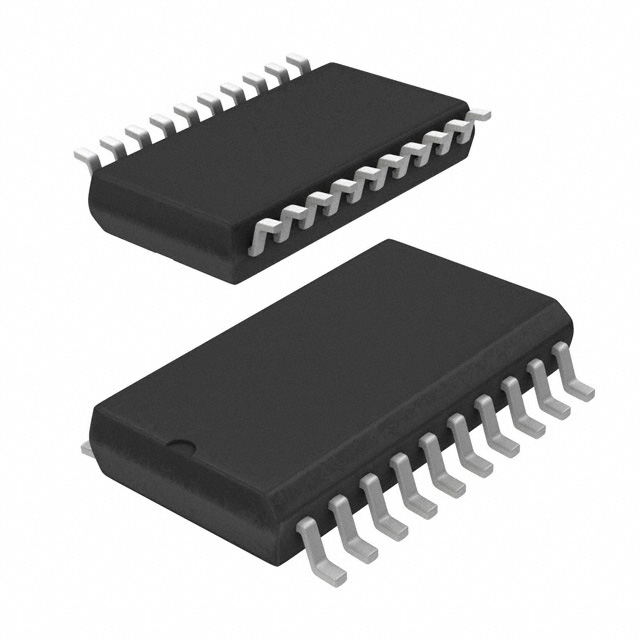Encyclopedia Entry: 74HC374D
Product Overview
Category
The 74HC374D belongs to the category of integrated circuits (ICs), specifically flip-flops.
Use
This IC is commonly used for storing and transferring digital data in various electronic devices and systems.
Characteristics
- High-speed operation
- Low power consumption
- Wide operating voltage range
- Compatibility with both TTL and CMOS logic levels
Package
The 74HC374D is available in a standard dual in-line package (DIP) with 20 pins.
Essence
The essence of the 74HC374D lies in its ability to store and manipulate digital information, making it an essential component in many digital systems.
Packaging/Quantity
The 74HC374D is typically packaged in reels or tubes, with quantities varying depending on the manufacturer's specifications.
Specifications
- Supply Voltage: 2V to 6V
- Input Voltage: 0V to VCC
- Output Voltage: 0V to VCC
- Operating Temperature Range: -40°C to +125°C
- Maximum Clock Frequency: 80 MHz
- Maximum Propagation Delay: 25 ns
Detailed Pin Configuration
The 74HC374D has a total of 20 pins, each serving a specific function. The pin configuration is as follows:
- GND (Ground)
- D0 (Data Input 0)
- D1 (Data Input 1)
- D2 (Data Input 2)
- D3 (Data Input 3)
- D4 (Data Input 4)
- D5 (Data Input 5)
- D6 (Data Input 6)
- D7 (Data Input 7)
- OE (Output Enable)
- CP (Clock Pulse)
- MR (Master Reset)
- Q0 (Output 0)
- Q1 (Output 1)
- Q2 (Output 2)
- Q3 (Output 3)
- Q4 (Output 4)
- Q5 (Output 5)
- Q6 (Output 6)
- VCC (Supply Voltage)
Functional Features
The 74HC374D offers the following functional features:
- Data storage and transfer capabilities
- Output enable control for multiplexing applications
- Master reset functionality for clearing stored data
- Compatibility with various logic levels, allowing seamless integration into different systems
Advantages and Disadvantages
Advantages
- High-speed operation enables efficient data processing
- Low power consumption contributes to energy efficiency
- Wide operating voltage range allows flexibility in system design
- Compatibility with both TTL and CMOS logic levels simplifies integration
Disadvantages
- Limited number of output pins may restrict certain applications requiring more outputs
- Propagation delay may affect real-time applications with strict timing requirements
Working Principles
The 74HC374D operates based on the principles of flip-flops. It utilizes clock pulses to latch and store incoming digital data. The stored data can then be transferred to the output pins upon receiving an output enable signal. The master reset pin allows for clearing the stored data when necessary.
Detailed Application Field Plans
The 74HC374D finds extensive use in various electronic applications, including but not limited to:
- Microcontrollers and microprocessors
- Digital communication systems
- Memory modules
- Data acquisition systems
- Industrial automation equipment
- Consumer electronics
Detailed and Complete Alternative Models
There are several alternative models available that offer similar functionality to the 74HC374D. Some notable alternatives include:
- SN74HC374N by Texas Instruments
- CD74HC374E by Texas Instruments
- MC74HC374AN by ON Semiconductor
- 74HCT374 by NXP Semiconductors
These alternative models can be considered based on specific requirements and availability.
In conclusion, the 74HC374D is a versatile flip-flop IC that provides efficient data storage and transfer capabilities. Its high-speed operation, low power consumption, and compatibility with different logic levels make it suitable for various electronic applications. While it has certain limitations, its advantages outweigh the disadvantages, making it a popular choice in digital systems design.
10個與74HC374D在技術方案中應用相關的常見問題與解答
Sure! Here are 10 common questions and answers related to the application of 74HC374D in technical solutions:
Q: What is the 74HC374D? A: The 74HC374D is a high-speed octal D-type flip-flop with 3-state outputs, commonly used in digital logic circuits.
Q: What is the maximum operating voltage for the 74HC374D? A: The maximum operating voltage for the 74HC374D is 6 volts.
Q: How many flip-flops are there in the 74HC374D? A: The 74HC374D has 8 flip-flops, making it an octal (8-bit) device.
Q: What is the purpose of the 3-state outputs in the 74HC374D? A: The 3-state outputs allow multiple devices to be connected together without causing conflicts or bus contention.
Q: Can the 74HC374D be used as a counter? A: Yes, the 74HC374D can be used as a counter by connecting the output of one flip-flop to the clock input of the next flip-flop.
Q: What is the maximum clock frequency for the 74HC374D? A: The maximum clock frequency for the 74HC374D is typically around 100 MHz.
Q: Can the 74HC374D be used in both synchronous and asynchronous applications? A: Yes, the 74HC374D can be used in both synchronous and asynchronous applications, depending on how the clock input is connected.
Q: What is the power supply voltage range for the 74HC374D? A: The power supply voltage range for the 74HC374D is typically between 2 and 6 volts.
Q: Can the 74HC374D be used in both positive and negative logic systems? A: Yes, the 74HC374D can be used in both positive and negative logic systems, as it has separate inputs for data and clock signals.
Q: What are some common applications of the 74HC374D? A: The 74HC374D is commonly used in applications such as address decoding, data storage, bus interfacing, and general-purpose digital logic circuits.
Please note that these answers are general and may vary depending on specific circuit designs and requirements.


